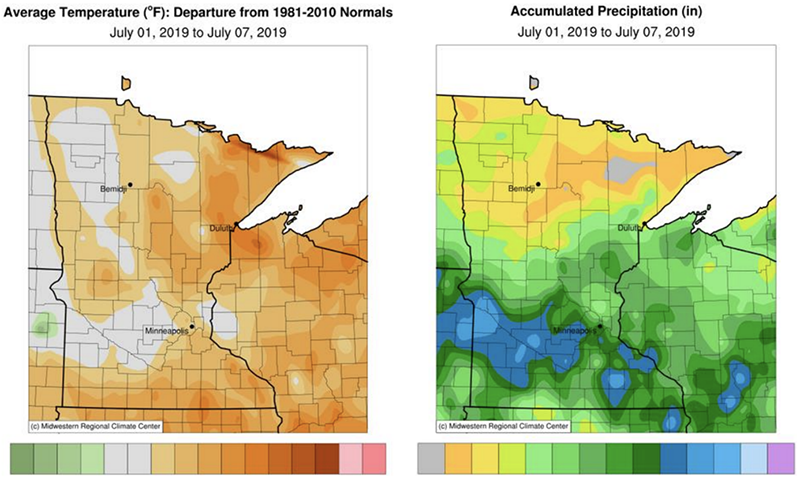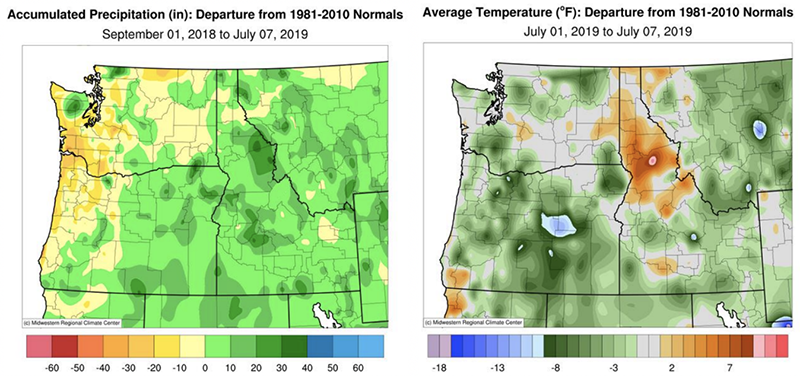Pulse crop planting is complete in the major pulse growing areas of the U.S., except for Michigan, where wet conditions early on caused significant seeding delays. Growers there are now catching up thanks to favorable weather. Elsewhere, the crop is almost fully emerged and the bean plants are starting to bloom.
Michigan
Michigan, a major black bean growing state, received a lot of wet and cool weather during the planting season, which slowed seeding. But conditions have since improved. Last week, 4.8 days were suitable for fieldwork and growers made significant progress on their dry beans. Planting progress advanced to 86% complete, which is still behind the average pace of 97% but up 21% from the week before. Bean crop emergence is at 49%, behind the average of 91%.
Minnesota
Minnesota is a key kidney bean growing state. Bean crop emergence is nearly 100%, with 6% of the plants blooming (which is about 5 days behind the average pace of 18%). As of July 7, the crop rated 5% very poor to poor, 30% fair, 50% good and 15% excellent. Conditions remain wet, especially in the southern half of the state, with top- and subsoil moisture rated 30 and 28% surplus, respectively.

Montana
Montana is a major producer of pulse crops. Last week, crops benefitted from good rains across the state. Emergence for dry beans (including chickpeas) was at 98%. Other pulses crops were further along, with 72% of the dry pea plants and 52% of the lentil plants in bloom. Dry pea crop condition ratings were 10% very poor to poor, 40% fair, 45% good and 5% excellent. The lentil crop rated 4% poor, 52% fair, 43% good and 1% excellent. Top- and subsoil moisture rated 86 and 78% adequate to surplus.
North Dakota
North Dakota is the country’s top dry bean producing state. Last week, 5.8 days were suitable for fieldwork. Top- and subsoil moisture levels were rated 80% and 78% adequate to surplus, respectively. The dry pea crop rated 2% poor, 18% fair, 74% good and 6% excellent with 67% of the plants blooming (behind the average of 75%). The dry bean crop rated 1% poor, 24% fair, 67% good and 8% excellent, with 9% of the plants blooming (behind the average of 17%).
Pacific Northwest
The Pacific Northwest is an important pulse producing region. Last week, the region received favorable weather across the board. In Idaho, with 95% crop emergence, the dry bean crop rated 47% fair, 44% good and 9% excellent. In Oregon, the bean crop rated 8% very poor to poor, 16% fair, 63% good and 13% excellent. In Washington, the bean crop rated 7% poor, 32% fair, 52% good and 9% excellent. In terms of the dry pea crop, in Idaho it rated 49% fair, 38% good and 13% excellent. In Oregon, the pea crop rated 21% very poor to poor, 21% fair, 39% good and 19% excellent. In Washington, it rated 3% poor, 22% fair, 68% good and 7% excellent.

Disclaimer: The opinions or views expressed in this publication are those of the authors or quoted persons. They do not purport to reflect the opinions or views of the Global Pulse Confederation or its members.